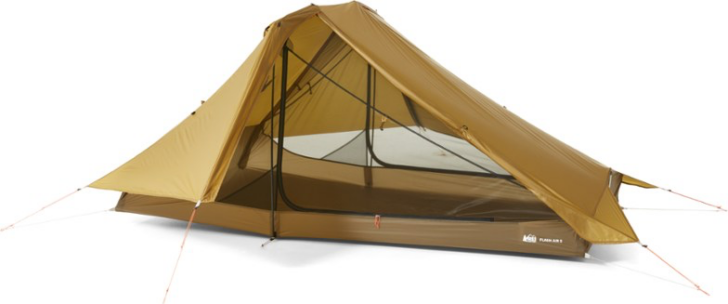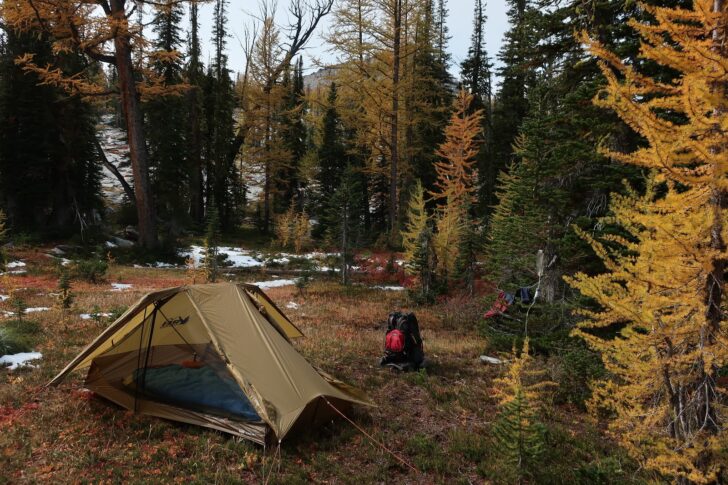Introduction
The REI Co-op Flash Air 2 Tent is a two-person hybrid single/double-wall shelter with dual entrances and vestibules. It is non-freestanding and can be pitched with two trekking poles to save weight or by using the included pole set. Its packaged weight is 40 oz (1,134 g), and its minimum weight is 31 oz (879 g). The MSRP of this model is $299. However, a solo model, the REI Co-op Flash Air 1 Tent (20 oz, 567 g) valued at $249, is also available. Backpacking Light has also published a review of the solo tent.
As a hybrid shelter, the REI Co-op Flash Air 2 Tent mixes and matches design components from traditional backpacking tents and single-wall shelters to create a product that features the best of both. The REI Co-op Flash Air 2 Tent provides reasonable livability for two persons and can also serve as a palatial single-person shelter.

Highlights
- Spacious interior, large vestibules, and ample headroom
- Small packed size and can be pitched using trekking poles
- Quick set-up and take-down
- Low weight and reasonable price
Where to Buy
Review Context

Although shelters really only have one job—to shelter you from the elements while backpacking—there is almost an endless permutation of criteria by which they can be evaluated on their overall value or quality. Protection from the elements, weight, livability, durability, ease of set-up, condensation, and a handful of other aspects of their performance, all factor into the overall quality of a shelter.
The importance with which each of these aspects is weighted (ultralight hikers, please pardon the pun), varies from person to person. Some people will choose a tent that requires a dozen stakes (titanium, of course), 100 feet (30 m) of 2 mm guyline cord, and a structural engineering degree to save a few ounces. Others will gladly haul around a two-person tent so they can stretch out inside, nevermind the extra weight. Some backpackers accept nothing less than a weatherproof reprieve, and cringe at the thought of spindrift blowing in under the vestibule. When it comes to shelters, one hiker’s DCF dream tent might be another hiker’s nightmare.
In over a decade of backpacking, I’ve spent hundreds of nights in a variety of shelters—bivy sacks, tarps, double-wall solo tents, single-wall solo tents (such as the Six Moon Designs Lunar Solo which I reviewed in 2019 for Backpacking Light), and double-wall two-person tents. After passing through various stages of shelter preference, I’ve more or less arrived at a place where I value an easy to set up, fully enclosed, roomy, lightweight tent slightly more than other options. When I arrive at a subalpine lake and see cutthroat trout rising, I want to be spending my time casting to them rather than adjusting trekking pole height and fiddling with guyline tension to get the perfect pitch on a featherweight shelter.
For the purposes of this review, I’ve done my best to evaluate this shelter from an objective standpoint, but my preferences regarding shelters undoubtedly influenced my overall impressions regarding this tent. I’ve focused on what I believe to be the most important performance criteria for the average lightweight backpacker. By examining the weight, weather protection, interior space, design, and other fundamental characteristics of the REI Co-op Flash Air 2 Tent, this review will provide those considering this tent with the insight necessary to determine if, overall, it will be a suitable shelter for them or if their priorities make a different shelter a better option.
Features and Specifications
Features
- Non-freestanding (requires six stakes minimum) shelter for two persons
- Dual doors and vestibules
- Hybrid single-wall design minimizes weight
- Hubbed pole design (can be pitched with trekking poles) creates roomy interior
- Quick set-up time with intuitive adjustment points
- Roof vents and vestibule design create ample air flow
- Fly rolls up to roof to allow for increased visibility and ventilation
- Neutral color blends in well with most natural landscapes
Specifications
- Minimum trail weight 31 oz (879 g); packaged weight 40 oz (1,134 g)
- Floor dimensions: 88 x 55/42 inches (length x width at head/foot) (224 x 140/107 cm)
- Floor area: 28.7 sq ft (2.6 sq m)
- Vestibule area: 16.8 sq ft (1.56 m)
- Peak height: 42 in (107 cm)
- Fly and floor materials: Ripstop nylon
- Nylon no-see-um mesh
- DAC NFL aluminum poles (2 hubbed poles required for pitching, 2 poles that can be substituted with trekking poles, 1 foot-pole)
- Packed size: 16 x 7 in (41 x 18 cm)
Performance Assessment

Description of Field Testing
This tent was tested for a total of 17 nights. For eight of those nights, I shared the tent with my girlfriend and hiking partner, Andrea. The other nine nights, I was the sole occupant. Andrea and I used the tent for four consecutive nights in a late August trip in Yellowstone National Park, and I used the tent solo for a three-night trip in Montana’s Pioneer Mountains. All other trips were overnight trips.
Testing occurred between late June and early October in Montana and Wyoming. The Bitterroot Mountains were the most frequent testing ground, followed by the Beaverhead-Deerlodge National Forest and Yellowstone National Park. The tent was pitched in less than ideal sites—open meadows with limited tree cover—as well as textbook locations where it was sheltered from wind and dew.

During testing, the tent was exposed to moderate winds (15 to 20 mph / 24 to 32 kph), thunderstorms, and rain showers. The tent was not exposed to any snowfall, hail, or high winds. I pitched this tent using both the included support poles and trekking poles. I staked it out using the minimum stakes in certain instances and utilized the additional guylines in others to evaluate its stability in various conditions.
In mild conditions, I slept with the fly as open as possible to increase ventilation and reduce condensation. In cooler temperatures or stormy conditions, the fly was closed with some ventilation created by unzipping the dual zipper near the fly’s top. The roof vents were left open throughout testing, even in inclement conditions.
Performance Criteria
I judged the REI Co-op Flash Air 2 Tent based on four major factors:
- Livability and Ease of Use
- Weather Resistance
- Ventilation and Condensation Management
- Quality
Livability and Ease of Use
Member Exclusive
A Premium or Unlimited Membership* is required to view the rest of this article.
* A Basic Membership is required to view Member Q&A events





Home › Forums › REI Co-op Flash Air 2 Tent Review